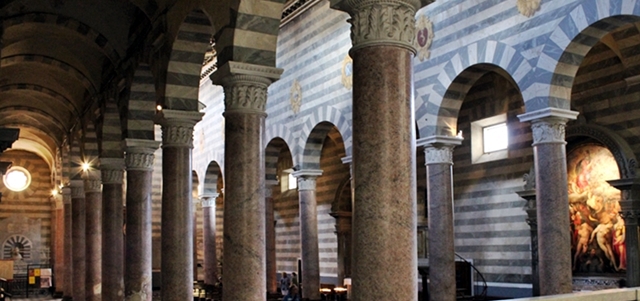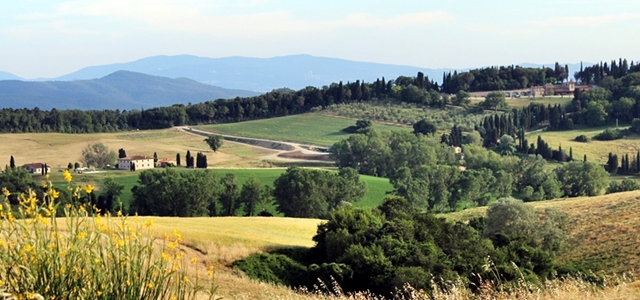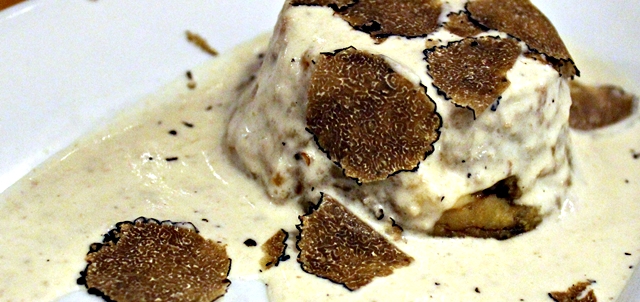Choose what to see and to do in Volterra

Volterra, Etruscans and alabaster
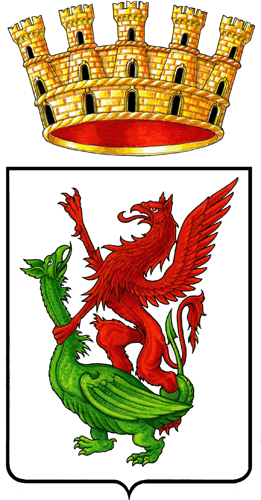 The city of Volterra, almost completely enclosed within the walls, has kept its medieval character and one can still enjoy the atmosphere of the past. Currently the economy of the area is mainly based on tourism, on artistic alabaster, known throughout the world, and on the extraction of rock salt. The alabaster artisan is one of the oldest professions which has a noble tradition, a high level craft exported world wide by many laboratories. Volterra is surrounded by the typical Tuscan countryside, but not only. One can find incredible scenaries in the geothermal area of Larderello, with unusual geysers, the forested and mountainous beauty of the river Cecina spring, ending at the Saline di Volterra.
The city of Volterra, almost completely enclosed within the walls, has kept its medieval character and one can still enjoy the atmosphere of the past. Currently the economy of the area is mainly based on tourism, on artistic alabaster, known throughout the world, and on the extraction of rock salt. The alabaster artisan is one of the oldest professions which has a noble tradition, a high level craft exported world wide by many laboratories. Volterra is surrounded by the typical Tuscan countryside, but not only. One can find incredible scenaries in the geothermal area of Larderello, with unusual geysers, the forested and mountainous beauty of the river Cecina spring, ending at the Saline di Volterra.
Few places in the world are able to offer a clear image of the past and the succession of civilizations like Volterra. Three thousand years of history have left their mark with continuity from the Etruscan period until the 19th century. There are artistic and monumental remains of great importance, which can be seen even just strolling in the old town. Together with these monuments unspoilt nature with an artistic handicraft unique in the world, the world of alabaster. To be mentioned the Etruscan Museum, the tower-houses, the medieval gates, the Cathedral and the Balze. Also interesting is visiting the various alabaster workshops.
[table colwidth=”20|100|50″ colalign=”left|left”]
AREA; Val di Cecina
TYPE; city of art
COORDINATES;43°24′00″N 10°52′00″E
ALTITUDE;531 meters o.s.l.
PRODUCTS; alabaster, truffle, honey, cheese, wine
SPORTS; trekking, cycling
BORDERS; Casole d’Elsa (SI), Colle Val d’Elsa (SI), Gambassi Terme (FI), Lajatico (PI), Montaione (FI), Montecatini Val di Cecina (PI), Peccioli (PI), Pomarance (PI), San Gimignano (PI)
HOW TO GET; by car from Pisa take FI PI LI motorway exit Pontedera Ponsacco, after continue on the SS 439 towards Volterra / from Florence take the highway to Siena exit Colle Val D’Elsa Poggibonsi, then follow the SS 68 to Volterra / by CPT coach from Pisa destination Pontedera Volterra
 Tourist Information
Tourist Information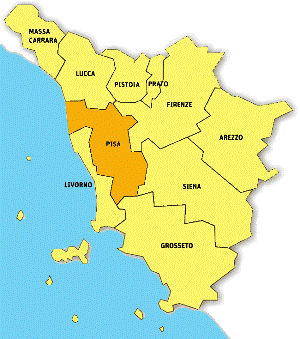
Municipality of Volterra
Piazza dei Priori, 1 – 56048 Volterra (PI)
Phone: +39 0588 86050
www.comune.volterra.pi.it
Tourism Office
Piazza dei Priori, 19
Phone: +39 0588 87257
ufficioturistico@volterratur.it
www.volterratur.it
WHAT TO SEE
Volterra fortress
Fortezza Medicea (Medici fortress)
 Area: Val di Cecina
Area: Val di Cecina
Type: fortification (16th century) – prison
The fortress is made up by two separate buildings, the Rocca Antica (Old Fortress) and Rocca Nuova (New Fortress), later joined together by the so-called “wall-walk.” Inside is a vast square. Rocca Antica, near Porta a Selci, includes a tower of semi-elliptical shape, also commonly known “The Female”. The New Fortress was commissioned by Lorenzo Medici (the “Magnificent”) exactly on the site of the former Bishop’s Palace, destroyed by the Florentine militia in 1472.
In the center is located Torre del Mastio, which is the most monumental part. In the intentions of the Medici, the Fortress had to be the military bulwark of the city, but soon lost this function and became a prison for the opponents of both the grandukes or Augsburg Lorene family. Even today has kept the same function, being a jailhouse.
Churches
Cattedrale of Sant'Assunta (Duomo)
 Area: Val di Cecina
Area: Val di Cecina
Type: cathedral (12th century)
Dedicated to Sant’Assunta, the cathedral was rebuilt in Romanesque style around 1120 on the site where there was an older church dedicated to Santa Maria. In the 13th century it was enlarged and embellished by Nicola Pisano. Inside there are several chapels with important paintings such as the panel depicting the Nativity of Mary, by Francesco Curradi (1618). The Chapel Serguidi, attributed to Giorgio Vasari and completed in 1595, was decorated with stucco work by Leonardo Ricciarelli and paintings by Giovanni Balducci.
In the Chapel of St. Hugh, inside the marble urn made in 1644 by countryman and artist Ludovico Incontri, the remains of Hugh Saladini, bishop of Volterra. In the Oratory of the Virgin Mary, the tabernacles in the wall contain two groups of statues in colored terracotta in the round and in size almost to the natural, attributed to Giovanni della Robbia. To the left of the crib with, in the background, a fresco by Benozzo Gozzoli representing the Procession of the Magi. The bell tower, located on the left side of the facade, is an elegant 15th century building.
Battistero di San Giovanni (Saint John Baptistery)
Area: Val di Cecina
Type: baptistery (13th century)
The building octagonal and crowned by a dome, dates back to the 13th century. Strips of green and white marble only adorn the facade, in which the portal is attributed to Nicola Pisano. The purse of the sculptures are by Mino da Fiesole and Alessandro Balsimelli from Settignano, while the board on the altar, Ascension into Heaven, was painted by Nicolò Cercignani in 1591. The old baptismal font was placed in the niche to the right. The five faces, carved in white marble in 1502 by Andrea Contucci, nicknamed Il Sansovino, are: Baptism of Christ, Faith, Justice, Charity, Hope. The current baptismal font is a work of John Vacca (1760).
Chiesa di San Francesco (Saint Francis Church)
 Area: Val di Cecina
Area: Val di Cecina
Type: church (16th century)
The building, of medieval origin, has undergone profound changes during the following centuries. Among the paintings placed above the altars are of particular interest Conception by B. Naldini (1585), Nativity by Balducci, Crucifix by Cosimo Daddi (1602). In an adjoining room a group of four figures, almost life-size, in color glazed earthenware are by Volterra citizen Zechariah Zacchi .
Chiesa di San Giusto (Saint Giusto Church)
 Area: Val di Cecina
Area: Val di Cecina
Type: church (17th century)
A big building that stands on the top of a grassy slope lined by two rows of cypresses. It was built in 1627 to replace a pre-existing church, which collapsed for a landslide. Inside the single nave, a sober architecture, important works are preserved: a painting by Cosimo Daddi, depicting Visitation of St. Elizabeth, a Giandomenico Ferretti canvas dating 1743, which depicts St. Francis Xavier preaching to the Indies, and a small table, originally the central part of a polyptych by Neri di Bicci (15th century).
In the oratory there is remarkable fresco by Baldassare Franceschini depicting Elia Sleeping. Overlooking the entrance of the oratory an interesting sundial (“gnomon”), designed by Giovanni Inghirami in 1801: the ray of light passes through a hole in the dome gnomic crossing the transept and falls on a meridian line, white marble, this one on the floor, indicates that throughout the course of the year, 12 hours.
Monuments and places to visit in Volterra
Palazzo dei Priori
 Area: Val di Cecina
Area: Val di Cecina
Type: historical building (13th century)
Address: Piazza dei Priori
The palace, built in 1239, has the shape of a parallelepiped. On the facade, above all, in the coat of arms of the captains who administered the city on behalf of Florence. Inside one can admire Crucifixion and Saints, a fresco by Pier Francesco Fiorentino, and Virgin and Child, attributed to Raffaellino del Garbo. Inside the palace were shooted several scenes of the film “New Moon”, the second chapter of the saga “Twilight” by Stephanie Meyer.
The Gates
 Area: Val di Cecina
Area: Val di Cecina
Type: historical gates
The walls of Volterra have various access doors of different origin. Those of particular interest are the following:
Porta etrusca
It undoubtedly survived over time because a portion of the Etruscan wall was incorporated into that one of the Middle Ages. The gate has undergone some minor changes, both in Roman medieval times.
Porta a Selci
Characterized by a simple arch, it was built in the 16th century to replace an older one, also called “del Sole”. From Porta a Selci, close to the Rocca Antica, branched off all roads towards Siena territory.
Porta Marcoli
It was perhaps built in the 14th century, and put in direct communication with the Olivetan monastery of St. Andrew. This gate and was mostly used by the farmers of the surrounding countryside.
Porta Fiorentina
Originally named S. Agnolo, because of the nearby church dedicated to the Archangel, has the same architectural structure of the other gates. In the arch, from where begins the road to Florence, are however visible alterations made in the 16th century. It was an obvious choice because, during the siege of 1530, the above tower (where ammunitions were stored) was hit and exploded.
 Porta di Docciola and Fonte di Docciola
Porta di Docciola and Fonte di Docciola
Built in the 13th century, it linked the city with the surrounding valley. The source, which is right in front of the door, dates back to 1254. It consists of two massive arches, within which there is a large rectangular tank, used as a public lavatory. Water also needed for some neighbors wool workshops and for some mills, located farther.
Porta San Francesco
Also known as St. Stephen or Pisana, because the road runs alongside Era river up to Pisa. It is the only gate that retains traces of frescoes on the ceiling, originally present in all the gates of the city.
Porta San Felice
It consists of one simple arch bar that relies on two disjoint trunks of castle walls, and has an abnormal appearance than the other city gates.
Porta Diana
What remains of Etruscan origin of this gate is outside the medieval walls, in the direction of Val d’Era. It is confirmed that beginning from this gate there was a road connecting the town to the main Etruscan necropolis.
The Tower-Houses (case-torri)
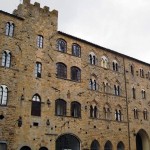 Area: Val di Cecina
Area: Val di Cecina
Type: tower-houses (13th century)
It is a fortified building, which is a fortress with both military and housing functions, which appeared in Italy in the 10th century. Built entirely of stone, it had generally a rectangular section, sometimes with a central tower. Normally the outer walls were thick, the windows small, while the gateway could even be located on the first floor.
Casa-Torre Buonparenti
Located in one of the most distinctive parts of the city, the tower-house is at an intersection of Borgo Santa Maria, urban expansion starting point in communal age. It is joined by a brick arch with Angelario fortress.
 Casa-Torre Toscana
Casa-Torre Toscana
It is a group of towers built in 1250 by John Toscano, treasurer of King Renzo of sardinia, becoming a real big luxury mansion later on.
Casa-Torre Baldinotti
On the ground floor there are series of arches surmounted by stone cones where, for the presence of shops in the place, the hinges of the doors opening on the road were fixed.
Persio Flacco Theater
 Area: Val di Cecina
Area: Val di Cecina
Type: theater
Address: Via dei Sarti, 4
Phone:+39 058884047
Email: info@palazzoviti.it
The theater is located inside Palazzo Incontri-Viti, better known as Palazzo Viti, dating from the 16th century. The facade is said to have been designed by Bartolomeo Ammannati. Persio Flacco is a fine example of Italian theater. In 1965 the film director Luchino Visconti used the rooms of the palace for some scenes of the movie”Vaghe Stelle dell’Orsa”, awarded with the prestigious Golden Lion.
Natural Reserves
Balze of Volterra
 Area: Val di Cecina
Area: Val di Cecina
Type: geological formations
Located between the valley of Cecina (Cecina Valley) and Era (Valdera) rivers, they are the most distinctive feature of the hill of Volterra. The connotations of the crags (gullies) are determined by the geomorphological characteristics of the area, made up of clay soils, loose and unstable. As a result the whole area has always been prone to landslides, which sometimes also damaged buildings and churches. The widespread forms of erosion, caused by weathering and made worse by the absence of vegetation, create landforms and spectacular stage effects.
ART AND MUSEUMS
Volterra museums
Museo Etrusco Guarnacci (Etruscan museum)
 Area: Val di Cecina
Area: Val di Cecina
Type: Etruscan museum
Address: Palazzo Desideri-Tangassi – Via Don Minzoni, 15
Phone: +39 0588 86347
Hours: all days 9.00-19.00 (summer) e 10.00.16.30 (winter)
It contains one of the most important collections of Etruscan art in Italy and one of the most important collection in the world of urns (over 600). A total of 38 rooms are connected through a trail that allows you to retrace the most important stages of the history of Velathri (the Etruscan name of the city). In the first rooms there are relics from the Neolithic (3000-2000 BC), the Bronze Age and the Iron Age, mainly offensive and defensive weapons from the necropolis of Pomarance, Guardistallo and Montebrandoni, indisputable evidence of the fact that the territory was intensely inhabited in prehistoric times.
In the middle of another hall has been rebuilt the so-called Badia Tomb, whose funeral equipment is exposed in a glass case adjacent to the crested helmet of the warrior from Poggio alle Croci. In the next room there is the greek-oriental style Stele of Avile Tite, dating to the fourth century B.C.: it reproduces a warrior with long hair, armed with a spear and a sword with a bird’s head handle. Of undoubted attractiveness are the rooms with urns depicting the journey of the deceased to the afterlife and mosaics inspired by Greek mythology. Lastly one of the masterpieces of Etruscan art: the terracotta cover machined on cue, portraying a married couple, and known as the Urn of the Spouses, bating back to 80-90 BC.
Alabaster museum
 Area: Val di Cecina
Area: Val di Cecina
Address: Palazzo Minucci-Solaini – Via dei Sarti, 1
Hours: all days 10.00 19.00 (summer) e 10.00-16.30 (winter)
The museum is located inside the medieval Palazzo Minucci. The exhibition, featuring a charming display, presents the story of alabaster from Etruscan times to the present day, through the presentation of all aspects: the techniques of ore mining and processing, the different types of materials, the stylistic characteristics, handicrafts and their sale. There is also the reconstruction of an old artisan workshop, including the tools used.
Civic Museum
 Area: Val di Cecina
Area: Val di Cecina
Type: art museum
Address: Palazzo Minucci-Solaini – Via dei Sarti, 1
Phone: +39 0588 87580
Tours: all days 9.00-19.00 (summer) e 10.00.16.30 (winter)
In the museum there are many valuable works such as the Deposition by Rosso Fiorentino, Annunciation and Virgin Enthroned with Saints by Luca Signorelli (both 1491), Christ in Glory with four saints and a donor of Domenico Ghirlandaio.
Diocesan Museum of Sacred Art
Area: Val di Cecina
Type: sacred art museum
Address: Palazzo Vescovile – Via Roma, 13
Phone: +39 0588 86290
E-mail: museoartesacravolterra@nemail.it
The collection is divided into two main areas: liturgical objects and works of art from both the Cathedral and other churches of the diocese. Complete columns capitals are exposed, holy water fonts, alabaster arms, relics, books. Remarkable is the Roman sarcophagus of the second century A.D., adapted in 1037 as the burial of Bishop Godfrey. Finally paintings of Benozzo Gozzoli and sculptures by Giambologna.
Archaeological sites
Archaeological Park Enrico Fiumi and Roman theater
 Area: Val di Cecina
Area: Val di Cecina
Type: Roman archaeological site (1th century B.C.)
An excavation, which took place in the 50s of last century, allowed the discovery and restoration of all structures which survived the centuries. The theater was built toward the end of 1th century BC, partially removing a portion of the hill slope, in analogy to the Greek theaters. It remained in operation until the late 3rd century and was abandoned later on. The ruins of the buildings are within the archaeological area, all open to visitors. In summer the old structure is used for performances of various kinds. In the nearby area there are the Etruscan ruins of the Acropolis, the necropolis and the remains of the Baths of S. Felice, all to be visited in a guided tour.
Artistic crafts
Alabaster
 Only in the early 18th century there was a true growth both in quantity and quality. It is indeed when expert skill artisans began to create excellent alabaster crafts that were to be known and appreciated in the whole world. Today there are few workshops left in the old town, but the tradition is jealously kept. Not by chance Art Association in Bottega was formed, which aims to safeguard, promote and raise awareness of all forms of manual work, art and art crafts.The origin of the name “alabaster” is undoubtedly Egyptian and perhaps derives from the city of Alabastron, formerly renowned for jars and small bottles used to contain perfumes.
Only in the early 18th century there was a true growth both in quantity and quality. It is indeed when expert skill artisans began to create excellent alabaster crafts that were to be known and appreciated in the whole world. Today there are few workshops left in the old town, but the tradition is jealously kept. Not by chance Art Association in Bottega was formed, which aims to safeguard, promote and raise awareness of all forms of manual work, art and art crafts.The origin of the name “alabaster” is undoubtedly Egyptian and perhaps derives from the city of Alabastron, formerly renowned for jars and small bottles used to contain perfumes.
It is a candid stone that, because of its particular softness, lends itself to be processed more easily than the marble. It is therefore very suitable to be carved in detail for small and rich ornamental crafts and to portray the smallest details of the human face, according to the canons of classical art. The Etruscans used it to build coffins and urns, adding rich decorations depicting the image of the deceased, along with scenes of everyday life, imaginary journeys to the underworld and episodes of the famous Greek mythology. They also painted the surface with mineral substances and, sometimes, covered it with thin gold foils.
Artistic goldsmith
The goldsmith and silver work has ancient roots and evolved particularly in valuable skills that continue today with a high level of craftsmanship.
WHAT TO DO
Events
Anno Domini 1398
 Type: folklore
Type: folklore
Website: www.volterra1398.it
When: fourth Sunday of August
It is a great celebration that evokes the glorious past of the town in medieval times and which is divided into various events, whose main theme changes every year. The moments of greatest attraction are the ones that coincide with Sunday, when the old town and the archaeological park are full of colorful performances, music, markets, taverns, craftsmen.
Volterrateatro
 Type: composite artistic show
Type: composite artistic show
When: July
The theatrical activity takes place inside the jailhouse, at the initiative of Compagnia della Fortezza, entirely made up of prisoners. The festival, originally a theater festival, has become a multidisciplinary event that includes music, dance, poetry, art and other cultural events.
VolterraJazz
 Type: music
Type: music
When: August
Astiludio
 Type: folklore competition
Type: folklore competition
When: first Sunday of September
It is a series of races between four teams of flag-wavers.
ITINERARIES
Itineraries near Volterra
The hiking trails are placed in an area where the landscape consists mainly of vast forests.
Norther valleys (Le valli settentrionali)
[table colwidth=”20|100|50″ colalign=”left|left”]
TYpe;historic natural trail (trekking, mountain bike)
AREA; Val di Cecina
DEPARTURE;Volterra
ARRIVAL; Borgo Santo Stefano
LENGHT; 15 kms
TIME; half a day
ATTRACTIONS; San Girolano, San Finocchi, mulini, Mamini, Etruscan tombs, Fonte della Frana, Borgo Santo Stefano
INFORMATIONS;
[/table]
It is a very suggestive itinerary that allows you to discover a very little known aspect of the Volterra landscape of chestnut trees and mills.
Upper Valdera valley (Alta Valdera)
[table colwidth=”20|100|50″ colalign=”left|left”]
TYPE;historic natural trail (trekking, mountain bike)
AREA; Val di Cecina
DEPARTURE;Volterra
ARRIVAL; Volterra
LENGHT; 25 kms
TIME; one full day
ATTRACTIONS; Roncolla, Monte Voltraio, Pignano, Sensano, Ulignano
INFORMATIONS;
[/table]
The hiking trails are placed in an area where the landscape consists mainly of vast forests. Villas, farmhouses and churches are scattered along the trail.
Monte Nero
[table colwidth=”20|100|50″ colalign=”left|left”]
TYPE;natural trail (trekking, mountain bike)
AREA; Val di Cecina
DEPARTURE;Volterra
ARRIVAL; Volterra
LENGHT; 15 kms
TIME; half a day
ATTRACTIONS; Scopicci, Cascatelle, Pieve della Nera, Casale Cafaggiolo, Monte Nero, Ulignano
INFORMATIONS;
[/table]
The hiking trails are placed in an area where the landscape consists mainly of vast forests. Several cliffs are visible along the trail.
Southern slope (versante meridionale)
[table colwidth=”20|100|50″ colalign=”left|left”]
TYPE;natural trail (trekking, mountain bike)
AREA; Val di Cecina
DEPARTURE;Volterra
ARRIVAL; Volterra
LENGHT; 15 kms
TIME; half a day
ATTRACTIONS; Cappuccini, railroad layout, Saline di Volterra, Moie vecchie, Scornello
INFORMATIONS;
[/table]
It is a very open and scenic journey that allows you to follow the route of the old cog railway that, from 1912 to 1958, connected the hamlet of Saline Volterra with the main city. The route also allows you to get in touch with an important part of the traditional economy, that of rock salt deposits.
GASTRONOMIA
Traditional dishes
Volterra cuisine
Wild boar with mushrooms and polenta
Hare of the three wines
Chickpea soup
Sorana bean soup
Typical products
Truffles
The typical truffles of the area are:
Black hooked Tuscan truffle
The truffle hamate (Tuber uncinatum Chatin) has an outer layer warty and black and a chocolate colored flesh, with numerous clear branched veins. This truffle has aroma and intense flavor.
Tuscan “scorzone” truffle
The scorzone (Tuber aestivum Vitt.) has an outer layer coarsely black warty, with large warts, pyramidal, and pulp from yellowish to bronze, with numerous clear and arborescent veins, which disappear after cooking. It has dimensions from those of a hazelnut to that of an apple. It has a delicate and pleasant fragrance, slightly brown spots.
White truffle of Tuscany
(Tuber magnatum pico Truffle) has a smooth outer layer, light yellow or light green, and a pulp from brown to hazel nuanced bright red, with light veins, fine and numerous that disappear after cooking. It has variable dimensions from those of a corn caryopsis to those of a big orange. It gives off a strong and pleasant scent.
Honey
The types of honey of the area are three:
Tuscan chestnut honey
Has a fairly liquid consistency, brown more or less dark and bright; strong bitter taste, smell and lingering scent of the forest.
Tuscan arbutus honey
It presents solid, with amber color, from gray-green tone. The taste is bitter and persistent, pungent smell.
Royal jelly
Royal jelly has dense texture and creamy-white; it is completely odorless, while the taste is sour. It is perishable and must be kept in the refrigerator.
Pecorino cheese
Pecorino cheese
It is a cheese made from raw milk that can be consumed both fresh and seasoned, but owes its aroma and its flavor to its special curing mode.
Ricotta cheese
The Tuscan sheep ricotta has a truncated cone shape, white colour, sweet and delicate flavor, creamy and spongy.
Farms - tasting and products
Podere Il Mulinaccio
Via Vicinale di Pretenzano, 108
Phone +39 0588 42050 / cell. +39 338 1498432
www.agriturismoilmulinaccio.it
ilmulinaccio@alice.it
Il Rifugio dei Sogni
Via Rioddi 71 Località Villa
Phone: +39 0588 80227 / mob. +39 347 0307450
www.ilrifugiodeisogni.com
ilrifugiodeisogni@outlook.com
Podere Marcampo
Locality San Cipriano – Podere Marcampo, 30 – 56048 Volterra (PI)
Phone: +39 0588 85393 / Mob. +39 348 5149782
www.agriturismo-marcampo.com
info@agriturismo-marcampo.com
Tenuta MonteRosola
Locality Pignano – 56048 Volterra (PI)
Phone: +39 0588 35062
www.monterosola.com
tenutamonterosola@gmail.com
Terre De’ Pepi
Via Cesare Battisti, 9 – Volterra (PI)
Phone: +39 340 0755911
www.terredepepi.it
frikvolterra@libero.it
Boutique del Tartufo
Vicolo Ormanni, 1 – 56048 Volterra (PI)
Phone: +39 348 7121883
www.boutiquedeltartufo.it
Tour “in search of truffles”: visitors will be driven to a truffle area. The tour will last approximately one hour during which a truffle expert will explain and demonstrate how it does look and how to find it with the help of a well-trained dog. Advanced reservations needed.
Formaggi Fratelli Carai
Locality Montemiccioli Podere Rimini – 56048 Volterra (PI)
Phone: +39 0588 35006 / Mob. +39 339 5975830
www.formaggicarai.it
formaggifratellicarai@live.it
Frantoio dei Colli Toscani
SR 439 dir. Km 7.400 Locality Molino d’Era – 56048 Volterra (PI)
Phone +39 0588 33233
www.frantoiodeicollitoscani.it
info@frantoiodeicollitoscani.it
Truffle tour
Boutique del Tartufo
Vicolo Ormanni, 1 – 56048 Volterra (PI)
Phone: +39 348 7121883
www.boutiquedeltartufo.it
Tour “in search of truffles”: visitors will be driven to a truffle area. The tour will last approximately one hour during which a truffle expert will explain and demonstrate how it does look and how to find it with the help of a well-trained dog. Advanced reservations needed.
CULTURA
History
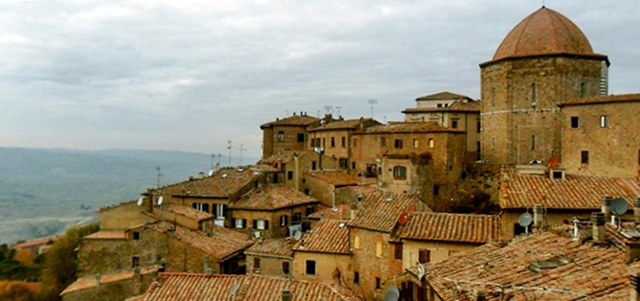 The privileged position on the top of a hill, overlooking the confluence of the valleys of Cecina and Era rivers, environmental characteristics and mineral resources favored the first human settlements since the Neolithic period (3000-2000 BC). In the 7th century B.C. the Etruscans built the first nucleus of the city, called Velathri. In the 4th century B.C. they built the defensive walls, the perimeter of which (over 7 kms) enclosed the village also the land used for grazing and cultivation. Grown in strength, Volterra became one of the twelve lucomonie which formed the so-called “Etruscan nation”, a kind of confederation. In the 3th century B.C. the area was conquered by Rome and became part of the “Confederation Italica”. To withstand the first barbarian invasions, in 5th century the city was organized. Despite the strengthening of the defensive structures it was conquered by the Heruli and, therefore, by the Goths and, during the Lombard kingdom, became the seat of a Gastaldo and a personal possession of the king.
The privileged position on the top of a hill, overlooking the confluence of the valleys of Cecina and Era rivers, environmental characteristics and mineral resources favored the first human settlements since the Neolithic period (3000-2000 BC). In the 7th century B.C. the Etruscans built the first nucleus of the city, called Velathri. In the 4th century B.C. they built the defensive walls, the perimeter of which (over 7 kms) enclosed the village also the land used for grazing and cultivation. Grown in strength, Volterra became one of the twelve lucomonie which formed the so-called “Etruscan nation”, a kind of confederation. In the 3th century B.C. the area was conquered by Rome and became part of the “Confederation Italica”. To withstand the first barbarian invasions, in 5th century the city was organized. Despite the strengthening of the defensive structures it was conquered by the Heruli and, therefore, by the Goths and, during the Lombard kingdom, became the seat of a Gastaldo and a personal possession of the king.
After being part of the domains of the Carolingian emperors, from the 9th to the 11th century Volterra was ruled by bishops and also became a center of religious, social and economic activities. In the first half of the 12th century the city was organized in free municipality. In this time, the Volterra area was already known for the production of salt and for the extraction of sulfur, vitriol and alum. At the same time Palazzo del Popolo was erected, and Piazza dei Priori, the “platea communis” (also called “meadow”) underwent the final arrangement. The Duomo and the Baptistry, which were the other main urban agglomerationr, were subject to major renovations.
In 1361, the city had to submit to Florence and was subjected to harsh treatment, which caused the emigration of many inhabitants. With the transformation of Tuscany in a grand duchy, the territory experienced a slow but gradual decline until the 18th century. We must wait the first half of the 19th century for a reversal: agriculture growth, and improvement in roads, mainly connections, expansion of alabaster processing and sale.
Curiosities
Torre del Porcellino (Porcellino Tower)

Palazzo Pretorio consists of several buildings and was the headquarter of the Podestà and Captains of the People. On the tower, unanimously considered one of the oldest in the city, there is the figure of a pig.
Films
 Volterra has inspired several literary and film locations, of which the main ones are:
Volterra has inspired several literary and film locations, of which the main ones are:
Forse che sì forse che no – novel by writer and poet Gabriele D’Annunzio (1910).
Chimaira – Valerio Massimo Manfredi’s novel.
Assassin’s Creed: Renaissance – the Oliver Bowde’s novel, from which he also obtained a video game. Set in the Renaissance, recounts the adventures of Ezio Auditore who, among the many enemies that appear in front of him, also faces a certain Antonio Maffei. This is one of the intransigent monks who formed an alliance with Uberto Alberti and the Florentine Pazzi family in the conspiracy to eliminate the Medici rivals.
The garden of prohibited herbs – Titania Hardie novel.
The Twilight Saga: New Moon – film by Chris Weitz (2008), based on Stephanie Meyer’s best-selling novel.
SERVIZI TURISTICI
Where to sleep
AGRITURISMO SERRASPINA
SERRASPINA – agriturismo in azienda biologica
 Indirizzo: Podere Serraspina, 35 – 56048 Volterra (PI)
Indirizzo: Podere Serraspina, 35 – 56048 Volterra (PI)
Tel. +39 0588 30188 / +39 329 9170882
Sito: www.serraspina.it
Email: info@serraspina.it
Servizi: 5 appartamenti (60 mq ciascuno) con riscaldamento, bagno, salotto con angolo cottura, frigorifero, TV satellitare e connessione W-IFI. Adatto a disabili, giardino, piscina all’aperto, escursioni trekking e mountain bike, ristorante con aria condizionata, cene per gruppi, corsi di cucina toscana.
 Ubicato nei dintorni di Volterra, la città dell’alabastro, l’agriturismo Serraspina occupa una superficie complessiva di 55 ettari. Oltre ai campi coltivati a grano con il metodo dell’agricoltura biologica, Serraspina è un luogo ideale per chi vuole trascorrere una vacanza immerso nella natura e godere del sole ai bordi della piscina o nel fresco boschetto di olmi. Nei dintorni, il paesaggio è caratterizzato dai calanchi e dalle “Balze” di Volterra, oltre a pievi di campagna tipiche di tutta la zona. Dall’agriturismo si raggiungono facilmente le città più prossime: oltre la vicina Volterra, San Gimignano, Siena, Firenze, Pisa oppure verso il mare, a Cecina.
Ubicato nei dintorni di Volterra, la città dell’alabastro, l’agriturismo Serraspina occupa una superficie complessiva di 55 ettari. Oltre ai campi coltivati a grano con il metodo dell’agricoltura biologica, Serraspina è un luogo ideale per chi vuole trascorrere una vacanza immerso nella natura e godere del sole ai bordi della piscina o nel fresco boschetto di olmi. Nei dintorni, il paesaggio è caratterizzato dai calanchi e dalle “Balze” di Volterra, oltre a pievi di campagna tipiche di tutta la zona. Dall’agriturismo si raggiungono facilmente le città più prossime: oltre la vicina Volterra, San Gimignano, Siena, Firenze, Pisa oppure verso il mare, a Cecina.
GLI APPARTAMENTI
 Ognuno degli appartamenti del complesso agrituristico ha un nome particolare legato a una tipologia di grano duro di cui l’azienda è una produttrice conosciuta. Tutti gli appartamenti hanno riscaldamento, bagno, angolo cottura, frigorifero, TV satellitare e connessione WI-FI.
Ognuno degli appartamenti del complesso agrituristico ha un nome particolare legato a una tipologia di grano duro di cui l’azienda è una produttrice conosciuta. Tutti gli appartamenti hanno riscaldamento, bagno, angolo cottura, frigorifero, TV satellitare e connessione WI-FI.

PREZZI
Tariffa giornaliera – B&B (pernottamento e prima colazione)
Tariffa – € 38,00 a persona in appartamento oppure € 60,00 con trattamento di mezza pensione
Bambini: sotto i 2 anni gratis; tra i 2 e i 10 anni 50% di sconto.
RISTORANTE
 Il ristorante propone solo menù tipici toscani ottenuti con prodotti rigorosamente della zona, dalla pasta, agli affettati, alle carni.
Il ristorante propone solo menù tipici toscani ottenuti con prodotti rigorosamente della zona, dalla pasta, agli affettati, alle carni.
CORSI DI CUCINA TOSCANA
Su prenotazione si organizzano corsi di cucina toscana.
PRODOTTI
Da qualche anno, l’azienda ha iniziato a produrre farro biologico. 
I prodotti sono certificati bio di alta qualità: perlato di farro, adatto a minestroni di legumi o insalate fredde con i prodotti dell’orto, pasta di farro, indicata con sughi vegetariani o con olio e formaggio e farina di farro, adatta per dolci e biscotti.
Where to eat
Restaurants, Taverns and Pizzerie
DA BEPPINO
Via delle Prigioni, 13 – 56048 Volterra (PI)
Tel. +39 0588 86051 / Cell. +39 329 2924482
info@dabeppino.com
www.dabeppino.co
Servizi: Pici al cacio e pepe di Volterra (pasta fresca fatta in casa), Arista di maiale di Cinta dell’Agricola, Risalso con fagioli all’uccelletta, Fragole con gelato, Acqua e un Calice di Vino di Volterra = € 28,00
EMPATHY BISTROT
Via Porta all’Arco, 13 – 56048 Volterra (PI)
Tel. +39 0588 81531
Servizi: Terrina di lenticchie con rapa rossa, crema di peperone, aspargi scottati e finocchio selvatico, Spaghetto al pomodoro con salsa di bufala mantecata, Cotoletta di fagioli con pane toscano einsalatina su salsa di pomodoro, Vino Cantina Terre de Pepi, acqua e caffè = € 30,00
DON BETA
Via Matteotti, 39 – 56048 Volterra (PI)
Tel. +39 0588 86730
info@donbeta.it
www.donbeta.it
TORRE DEL PORCELLINO
Vicolo delle Prigioni, 16 – 56048 Volterra (PI)
Tel. +39 0588 86392 / +39 347 5636777
info@torredelporcellino.it
www.torredelporcellino.it
Servizi: Zuppa di fave € 10,00, Vellutata etrusca, passato di ceci e lenticchie servito con un cucchiaio di farro € 11,00, Agnello arrosto su pesto di menta accompagnato da un cucchiaio di miele e radicchio scottato € 15,00, Cinghiale con mela caramellata e cipolla di Certaldo cotta al vino € 14,00
VOLATERRA
Via G.Turazza, 5/7 – 56048 Volterra (PI)
Tel. +39 0588 88765
info@volaterra.it
www.volaterra.it
Servizi: Taglieri di specialità gourmet da aziende del territorio
PIZZERIA ALLA VECCHIA MANIERA
Via Ricciarelli, 38 – 56048 Volterra (PI)
Tel. +39 0588 88819
Wine shops
LE CANTINE DI PALAZZO VITI
Via dei Sarti, 39 – 56048 Volterra (PI)
Tel. +39 0588 80033 / cell. +39 348 9005419
info@lecantinedelpalazzo.it
www.lecantinedelpalazzo.it
Servizi: Lingua salmistrata con giardiniera di verdure, Reginette al cinghiale, Peposo di manzo o Lampredotto della casa Cantuccini toscani con vino dolce bevande e caffè = € 25.00
RISTORANTE ENOTECA DEL DUCA
Via di Castello, 2 – 56048 Volterra (PI)
Tel.+39 0588 81510
Fax 0588 92957
info@enoteca-delduca-ristorante.it
www.enoteca-delduca-ristorante.it
Servizi: Pecorino volterrano fritto su julienne di verdure con controfiletto alle erbe aromatiche, Ravioli di cinghiale in salsa di cannellini al profumo di rosmarino, Coscio di coniglio disossato alla Vernaccia con olive nostraline, capperi e purè di patate, Degustazione di dessert = € 38,00 bevande escluse











